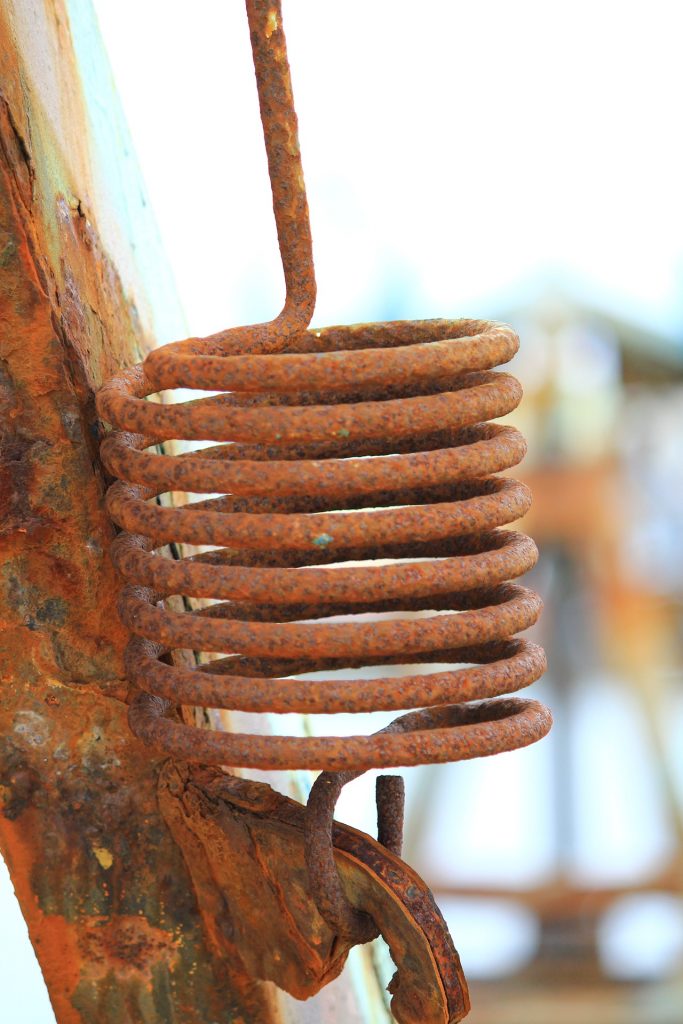Is the movement of your garage door all out of whack? Does it jerk when lifting and lowering, or have trouble moving along the tracks? Most likely, your garage door springs need repaired or replaced. The springs on your garage door are one of the hardest working parts of the garage door opener’s infrastructure. They use torque or tension to help the opener lift and lower the garage door.
If you want to save money on garage door repair, knowing which type of spring is most cost effective is crucial. Let’s take a look at the different types of garage door springs. How do you know which one is the most cost effective in the long run for you? (Spoiler alert! It’s not always the cheapest.)

Why the Type of Garage Door Spring is Important
We don’t often think about our garage door springs until there’s a problem. But they are critical components of your garage door. If they aren’t in top working shape, springs can pose a danger to children, pets, cars and other property. That’s why if there is ever any part of your garage door springs that are misshapen or malfunctioning, you should contact a professional immediately.
First, you’ll need to identify which type of spring is on your garage door. And then you’ll have to get familiar with the specs, to help you decide if it’s time to replace your garage door’s current springs with new, upgraded ones.
The Standard Garage Door Spring: Torsion
The most common garage door spring by far is the standard torsion spring. This spring looks like one of those metal slinkies from the ‘80s, arranged in a standard coil. The length, width, and diameter will vary according to the size, weight and desired speed of the garage door.
Torsion springs tend to last 10,000-20,000 cycles — the number of times a garage door can go up and down before the spring needs replaced. Garage door torsion springs are usually installed in pairs at the inside top of the garage door, on either side of the trolley track.
Since your average garage door is used several times a day, a rough guide is about 1,000 cycles per year. Therefore a 10,000 cycle spring will last roughly 7 to 10 years, depending on frequency of use. Most standard garage doors have standard torsion springs, hence the name. Some garage doors have dual springs. Be sure to note how many springs your garage door takes.
The OG Garage Door Spring: Extension
Older garages as well as manual garage doors might still have extension springs as their garage door opening mechanism. These springs sit on either side of the garage door and use stretching and rebound to help the opener lower and lift the door. Extension springs are anywhere from 30% to 50% cheaper than torsion springs, but they also last only about half the time garage door torsion springs do.
When it comes to use, extension springs have two other caveats. One, they make for noisier, less smooth operation than do torsion springs. This can wear out other garage door parts more quickly. Two, when an extension spring breaks, the broken end can whip around, damaging people or property in its path, where torsion springs unravel in place, and are also more out of the way than extension springs are.
The Upgraded Torsion Spring: TorqueMaster
Wayne Dalton has taken the torsion spring game up a notch with a new type of torsion spring: the TorqueMaster. What’s different? It’s an all-around safer type of garage door spring. The spring itself is encased in a tube that provides you access to the end fittings without exposing you to the actual coil.
This offers two advantages: (1) you’re protected from the spring should it break or suddenly unwind, and (2) the spring is protected from the elements, which can help it last longer.
The High-Performance Garage Door Spring: High-Cycle
There are garage door springs that have higher cycles, but they’re also more expensive. However, since these springs tend to last 150% longer than your standard garage door torsion spring, they tend to be more cost-effective in the long run.
In addition to the benefit of higher cycles, these springs also improve the functioning of the garage door itself, providing easier, smoother movement. Keep in mind that some garage doors are not equipped to handle these types of springs. Check with a garage door professional to see which type of spring is compatible with your garage door.
Can I Convert My Garage Door from One Spring to Another?
The good news is, if your garage door is fairly new, you can likely use any spring you want, including higher cycle springs. And though higher cycle springs are more expensive, they’re more durable and last longer. So if you plan to own your home long enough to benefit from longer lasting garage door springs, they’re not actually more expensive at all.
But what do you do if your garage door is old and only set up for extension springs? No worries – we can convert you to a torsion spring system! This will also be the perfect chance to upgrade your garage door opener to an SB969-compliant battery-backup model.Have more questions about garage door springs and how you can optimize your garage door’s operations? Give us a call anytime; we’re happy to help!
